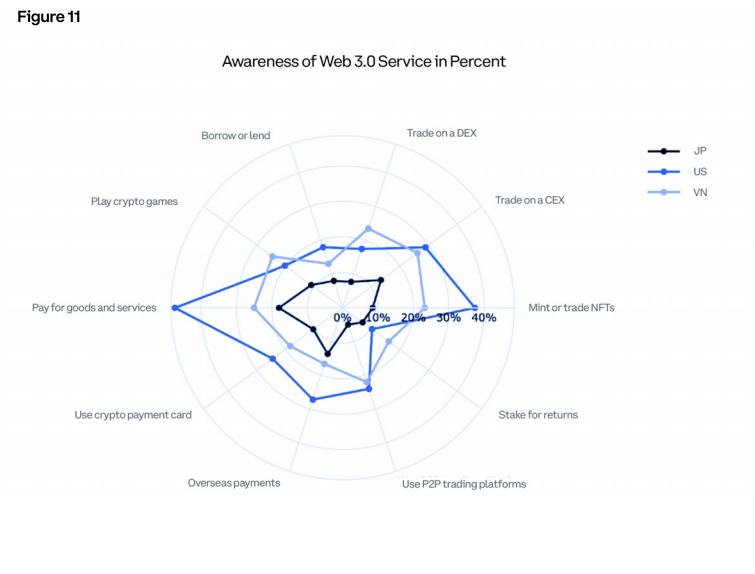Wen Web? The Decentralized Internet’s Current State and 2024 Odds
Oct. 11, 2023.
7 min. read.
20 Interactions
Web3: Bridging Hype and Reality. Is the Web3 revolution approaching, or is it all talk? Explore global adoption, barriers, and Asia's role in this crypto evolution.
Introduction
Since the start of the decade, Web3 has been touted as our salvation from the ills of Web2, as the fully decentralized foundation for a censorship-free new Internet that preserves privacy and restores the cypherpunk vision of the 1990s, with extra power-ups unlocked by distributed ledger and cryptocurrency technology (in particular AI cryptos this year) on blockchains like Ethereum and Cardano.
Web3’s hype train derailed in late 2021 and throughout 2022, as record inflation, rising interests, and a cascade of centralized custodial blowups deflated crypto markets. However, hope springs eternal in the world of digital assets. With 2024 just around the corner, filled with the promise of the Bitcoin halving, spot ETFs (for both BTC and Ethereum), a pivot in global macro-economic policy, and other wonderful things, the talk around Web3 is heating up again, especially in Asia, even if artificial intelligence has stolen a lot of the thunder and VC funding this year.
Will 2024 or 2025 be the Year of Web3, or is it all just a wishful thinking, bad investments, and the echo chambers of Crypto Twitter and YouTube? What does the average person know about Web3.0?
An extensive survey conducted by major US cryptocurrency exchange Coinbase, called the “International Survey of Web3 adoption”, polled over 32,000 internet users across 16 countries. The countries span developed economies like the US and Japan as well as emerging markets like the Philippines and Vietnam. This provides a valuable snapshot of how Web3 technologies are being embraced on a global scale.
The 16 countries were: the United States, Canada, and Brazil in the Americas; the United Kingdom, Germany, Italy, France, Spain, and the Netherlands in Europe; and in the Asia-Pacific region Australia, Philippines, Indonesia, India, Thailand, Vietnam, and Japan.
Survey Broad strokes: Demographics and Web3 Awareness
With a 50-50 gender split, the survey captures a balanced view from both men and women. Most respondents are city dwellers (46%), with a good mix of suburbanites (32%) and rural folks (21%). Education and income levels are all over the place, from high school dropouts to advanced degree holders, and from low to high earners.
A whopping 80% of people know about cryptocurrencies, and two-thirds have heard of at least one Web3 use case. Europe is leading the pack in awareness, while emerging countries and, oddly enough, Japan are lagging.
The report suggests social media platforms play a vital role in driving awareness of Web3, especially in emerging market countries. Up to 2 in 5 cryptocurrency users rely on sources like YouTube, Facebook, Twitter, and cryptocurrency websites for information. Far fewer – only 16% to 26% – rely on mainstream news sources.
So what’s hot in Web3 right now? Trading on centralized exchanges (sadly) and blockchain gaming are the go-to activities. Nearly half of Web3 users have a software wallet, and about 30% are rocking a hardware wallet.
Looking ahead, the survey predicts a 50% surge in Web3 adoption by 2026. The future looks especially bright in developing countries, where crypto is becoming the new way to pay. When questioned about specific Web3 use cases, the applications most familiar to respondents were cryptocurrency payments, NFT trading, and trading on centralized cryptocurrency exchanges (CEXs). Despite the regulatory alarms, centralized exchanges are still the main gateway to the Web3 world.
33% were familiar with crypto payments, 24% with NFT trading, and 23% with CEX trading. Comparatively, awareness of more complex and risky decentralized finance (DeFi) activities like staking, decentralized exchange trading, and borrowing/lending were significantly lower; roughly 1 in 6 people were familiar with DeFi staking, trading, and lending or borrowing.
Web3 Services
One of the most commonly used Web3 services after centralized cryptocurrency exchanges (CEXs) is crypto gaming platforms, while self-hosted cryptocurrency wallets, both software and hardware, are gaining increased mainstream traction and adoption.
The report suggests CEXs currently serve as the primary entry point for most people into the Web3 ecosystem, providing a bridge to the mainstream finance world. Despite growing regulatory scrutiny, CEXs are expected to continue spearheading cryptocurrency adoption into the future.
When survey respondents who had used Web3 before were asked about their initial experiences, trading on CEX platforms emerged as the number one entry point, accounting for 21.1% of first interactions. This aligns logically with CEXs often being the first stop for users looking to convert fiat currency into cryptocurrency.
Interestingly, the report also highlights how initial entry points into Web3 differ significantly between countries. In developed nations, CEX trading was by far the most common gateway into Web3, likely because people in these regions are already familiar with using financial systems.
On the other hand, in emerging market countries like the Philippines and Vietnam, playing crypto games emerged as the most popular entry point. This may be boosted by play-to-earn crypto games providing income generation opportunities during COVID-19 for lower-income users.
Below are ten use cases ranked from most to least familiar:
- Crypto Payments (33%)
- NFT Minting/Trading (24%)
- Trading on Centralized Exchanges (23%)
- Overseas payments (23%)
- Playing crypto games (23%)
- Using P2P trading platforms (19%)
- Use of crypto payment card (18%)
- Staking for returns (17%)
- DEX Trading (16%)
- Borrowing/Lending (13%)

Barriers to Entry
Among respondents who had not used Web3 before, around 46% cited a lack of knowledge about Web3 technology as a key barrier to adoption. Over 25% of non-users also noted they simply did not know where to begin exploring the space.
Beyond educational barriers, concerns around volatility, hacks, scams, and government regulation also deterred usage among some respondents. Regulation concerns were particularly acute in some countries, like India and Canada, where 26% of respondents cited this as a barrier.
Web3 in Asia
The Coinbase report notes that Asia contains countries at varying levels of technological adoption, and with diverse regulatory environments. During the pandemic, Asian crypto markets and innovations played a vital role in sustaining Web3 development globally.
Here are some insights:
- Japan has comparatively low awareness of Web3, likely due to a challenging regulatory environment including high crypto taxes. This has led many crypto firms to choose alternative locations for their operations.
- Emerging countries like the Philippines exhibit greater Web3 awareness than more developed nations. The Philippines has a young, tech-savvy population with high remittance flows that could benefit from blockchain technologies.
- Vietnam has low Web3 awareness currently but a rapidly growing interest in blockchain and crypto, particularly for gaming.
- Gaming and metaverse participation are more popular Web3 use cases in Asian emerging markets compared to developed countries.
- Developed Asian countries focus more on crypto payments and financial services, whereas emerging markets prioritize remittances more.
The Promise and Potential of Web3
Web3 carries enormous potential across a wide range of use cases like supply chain management, digital identity, healthcare, and insurance. However, there are challenges between the potential and the actual.
- The decentralized nature of Web3 makes scalability difficult, as the network waits on nodes to validate transactions.
- Interoperability issues arise from the multitude of different blockchains that don’t always work together seamlessly.
- Usability remains a barrier, with many Web3 applications having non-intuitive user experiences.
But Web3 momentum is clearly building. Monthly active developers have surged 297% since 2018. Gartner predicts 25% of enterprises will use Web3 applications by 2024. With solutions in areas like decentralized finance and play-to-earn gaming already demonstrating value, Web3’s possibilities are vast despite current limitations.

The Outlook for Web3 in 2024
The prognosis for Web3 adoption by 2024 looks positive, as developers work to address current challenges. Improved scalability, interoperability, and usability will likely emerge to make Web3 more accessible to mainstream audiences.
Familiar technological challenges remain though:
- Scalability: Web3’s decentralized structure hampers easy scaling, limiting its adoption.
- Interoperability: Multiple blockchains exist, but they don’t always sync well, affecting Web3 adoption.
- Usability: Complex Web3 apps deter users, posing a barrier to widespread adoption.
- Blockchain projects often over-promise and under-deliver, eroding trust and adoption.
- Onboarding process: Clunky onboarding experiences can kill user interest, hindering adoption.
On the plus side, as more and more people become more familiar with Web3 capabilities, adoption is expected to accelerate, across ever more diverse use cases. Custom-built and application-specific modular blockchains will simplify development, and the eventually ubiquitous implementation of zero-knowledge rollup proofs will enable greater security and privacy.
While the Coinbase report shows it’s still early days, Web3 is rapidly evolving. Its awareness is reasonably high worldwide, but substantial barriers around education and regulation still remain and will have to be dealt with.
If you’re a business looking to ride the Web3 wave globally, you’ve got to be a bit of a cultural chameleon. Different places have their own vibes, especially in the diverse landscape of Asia. So, understanding the local scene – be it regulations, economics, or even just what people are into – is key.
Looking ahead, Web3 is set to graduate from being this edgy, niche thing to becoming part of our daily lives and how we do business, turbocharged by emerging tech like AI and machine learning. Buckle up for the future!
Let us know your thoughts! Sign up for a Mindplex account now, join our Telegram, or follow us on Twitter.

.png)

.png)


.png)






4 Comments
4 thoughts on “Wen Web? The Decentralized Internet’s Current State and 2024 Odds”
The potential of Web3 is incredible, and it's great to see that developers are working on addressing its current challenges. As scalability, interoperability, and usability improve, we're looking at a promising future for Web3!
🟨 😴 😡 ❌ 🤮 💩
It's clear that Web3 is on the rise, and 2024 could be its year to shine. With increasing awareness and a bright future in developing countries, we're in for a wild Web3 ride!
🟨 😴 😡 ❌ 🤮 💩
This dishes out some jolly interesting insights into the world of Web3, but it's as clear as a sunny day that there are still a fair few hurdles to overcome. Education and regulation are proper big barriers to widespread adoption, they are, no denying that.
But you know what really grinds my gears, mate? It's the hype and the lack of real impact on the lives of the bloke next door like meself. I'm getting a tad worried 'ere, 'cause all these recent hypes seem a bit useless when we weigh 'em on the utility scale, innit?
🟨 😴 😡 ❌ 🤮 💩
This article is seriously mind-blowing! Web3 is gaining momentum, and the fact that it's predicted to surge by 50% in adoption by 2026 is just awesome. Get ready for a Web3 revolution!
🟨 😴 😡 ❌ 🤮 💩